Scriptural books that have not been included in the current versions of the Bible. The word is derived from the Greek apokryphos, which means “hidden.” The Bible is a collection of separate documents that have been gathered through the centuries. Different traditions such as Judaism, the Catholic Church, the Protestant churches, or the Eastern Orthodox Church, do not fully agree on which books or documents are to be recognized and included in the Tanakh (the Old Testament) or the New Testament. Those which are accepted are considered as “canonical,” while those which are excluded are apocryphal. There are several related terms that must be mentioned in this regard:
1. What Protestants call canonical, that is, the 39 books of the Old Testament, are called protocanonical by Catholics.
2. The Catholics recognize seven other books in the Old Testament, and these they call deuterocanonical, which means “added to the canon.” These are called the apocrypha by the Protestants.
3. What Catholics call apocryphal are books outside of the protocanonical and deuterocanonical collections. These however are called pseudepigraphia by the Protestants, which means “false writings.”
Old Testament Apocrypha. The canonical books accepted by all the versions of the Bible are those found in Protestant Bibles such as the King James Version or the Revised Standard Version, as well as the Hebrew Torah. Catholic Bibles such as the New American Version or Douay Version, as well as Greek and Slavonic Bibles, include the following: Tobit, Judith, Esther, Wisdom of Solomon, Ecclesiasticus, Baruch, Letter of Jeremiah, 1 Maccabees, 2 Maccabees, and additions to the Book of Daniel (Prayer of Azariah, Susanna, and Bel and the Dragon).
The following additional books are in the Greek and Slavonic Bibles: 1 Esdras (same as 2 Esdras in the Slavonic), Prayer of Manasseh, Psalm 151, and 3 Maccabees.
The Slavonic Bible also contains 3 Esdras. The Greek Bible has added 4 Maccabees.
The Old Testament books are supposed to be the same as the books of the Hebrew Torah. However, in the third century BCE, a Greek translation of the Hebrew Torah was made, called the Septuagint (or LXX, named after the 70 scholars who supposedly translated it at the request of King Ptolemy II of Egypt) which contained books that were not found in the Torah. It became the standard scripture of the Christians for more than three centuries. When it was being translated into Latin, the issue about which books to include became an important and urgent matter. When Jerome translated the Septuagint into the Latin Vulgate version in 405 CE, he excluded the books which were not in the Hebrew Torah. Augustine, however, advocated the acceptability of the apocryphal books. In the Council of Carthage in 397 CE, and later in the Council of Trent in 1548 CE, these books were declared as canonical. Protestant translations at first separated the apocryphal books as appendix of the Bible. Later, they were entirely excluded.
In addition to the above-mentioned apocryphal books, there are other Jewish books which have at one time or another been considered as scriptural, such as 1 Enoch, 2 Enoch, 4 Baruch (also known as Paraleipomena), The Books of Adam and Eve, The Life of Adam and Eve, The Book of Jubilees, Martyrdom of Isaiah, Apocalypse of Moses, Revelation of Esdras, Prayer of Manasses, and Sibylline Oracles.
New Testament Apocrypha. The New Testament canons of the Roman Catholics and Protestants are essentially identical except that the Roman Catholic Bible includes 12 verses to the Gospel of Mark (Mk 16:9-20) which are not included in Protestant versions.
There are also numerous books which are considered as New Testament apocrypha, classified under gospels, acts, epistles and apocalyptic writings. The major ones are the following:
1. Gospels
Infancy Gospel of Thomas: Latin Text
Arabic Infancy Gospel
Gospel of James
Gospel of the Nativity of Mary
Gospel of Mary of Bethany (or Magdalene)
Gospel of Pseudo-Matthew
Gospel of Nicodemos (The Acts of Pilate)
Gospel of Bartholomew
Gospel of Peter
Gospel of the Lord by Marcion
Secret Gospel of Mark
Pistis Sophia
2. Acts
Acts of Andrew
Acts and Martyrdom of Andrew
Acts of Andrew and Matthew
Acts of Barnabas
Acts of John
Acts of John the Theologian
Acts and Martyrdom of Matthew
Acts of Paul
Acts of Peter
Acts of Peter and Andrew
Acts of Peter and Paul
Acts of Philip
Acts of Thomas
Consummation of Thomas
3. Epistles
Epistle of the Apostles
Apocryphon of James
3 Corinthians
Laodiceans
Letter of Peter to Philip (1st part)
Correspondence of Paul and Seneca
Epistle of Titus
4. Apocalyptic Writings
Revelation of John the Theologian
Revelation of Paul
Apocalypse of Peter
Revelation of Stephen
Apocalypse of Thomas
Apocalypse of the Virgin
Regarding the New Testament apocrypha, Helena P. BLAVATSKY wrote: “The apocryphal gospels contain far more historically true events and facts than does the NT, the Acts included. The former is . . . made up legend” (CW XIV:109).
V.H.C.
© Copyright by the Theosophical Publishing House, Manila
 This Theosophical Encyclopedia contains all the articles of the printed Theosophical Encyclopedia published by the Theosophical Publishing House, Manila. In addition, new articles that are not in the printed version are continually being added. Many of the articles are also being updated.
This Theosophical Encyclopedia contains all the articles of the printed Theosophical Encyclopedia published by the Theosophical Publishing House, Manila. In addition, new articles that are not in the printed version are continually being added. Many of the articles are also being updated. This Theosophical Encyclopedia contains all the articles of the printed Theosophical Encyclopedia published by the Theosophical Publishing House, Manila. In addition, new articles that are not in the printed version are continually being added. Many of the articles are also being updated.
This Theosophical Encyclopedia contains all the articles of the printed Theosophical Encyclopedia published by the Theosophical Publishing House, Manila. In addition, new articles that are not in the printed version are continually being added. Many of the articles are also being updated.